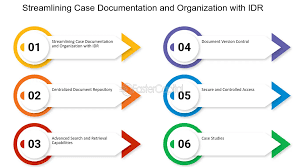
The Benefits of a Centralized Document Repository
In today’s fast-paced business environment, managing documents efficiently is crucial for productivity and collaboration. One solution that organizations are increasingly turning to is a centralized document repository.
A centralized document repository is a single, secure location where all documents and files are stored, organized, and easily accessible to authorized users. This centralization offers several key benefits:
- Improved Organization: By storing all documents in one place, it becomes easier to categorize, search, and retrieve files quickly. This streamlines workflows and reduces the time spent searching for information.
- Enhanced Collaboration: A centralized repository allows team members to access and work on the same documents simultaneously. This fosters collaboration, eliminates version control issues, and ensures that everyone is working with the most up-to-date information.
- Increased Security: Centralizing documents in a secure repository helps prevent data breaches and unauthorized access. Access controls can be implemented to restrict who can view, edit, or delete specific files, ensuring sensitive information remains protected.
- Efficient Backup and Recovery: With all documents stored in one location, it becomes easier to implement regular backups and disaster recovery plans. In the event of data loss or system failure, organizations can quickly restore their documents from backups stored in the repository.
- Audit Trail and Compliance: Centralized repositories often provide audit trail capabilities that track who accessed or modified documents. This feature is essential for compliance with regulations such as GDPR or HIPAA.
In conclusion, a centralized document repository offers numerous advantages for organizations seeking to streamline document management processes, enhance collaboration among team members, improve security measures, and ensure regulatory compliance. By implementing a centralized repository system, businesses can boost efficiency, productivity, and data integrity in today’s digital age.
5 Essential Tips for Managing a Centralized Document Repository
- Ensure proper organization of documents with clear naming conventions and folder structures.
- Implement version control to track changes and updates made to documents over time.
- Set access permissions to restrict document viewing and editing only to authorized personnel.
- Regularly back up the repository to prevent data loss in case of system failures or errors.
- Train employees on how to use the centralized document repository effectively for seamless collaboration.
Ensure proper organization of documents with clear naming conventions and folder structures.
To maximize the benefits of a centralized document repository, it is essential to ensure proper organization by implementing clear naming conventions and logical folder structures. By establishing consistent naming practices and structuring folders in a way that reflects the content hierarchy, users can easily locate and identify relevant documents within the repository. This approach not only streamlines document retrieval but also promotes efficient collaboration and information sharing among team members. Clear organization is the foundation for effective document management within a centralized repository, facilitating productivity and ensuring that valuable information is readily accessible when needed.
Implement version control to track changes and updates made to documents over time.
Implementing version control in a centralized document repository is a crucial tip to track changes and updates made to documents over time. Version control allows users to view the history of a document, revert to previous versions if needed, and ensure that everyone is working with the most recent iteration. By maintaining a clear record of edits and modifications, organizations can enhance collaboration, mitigate errors, and maintain data integrity within their document management system.
Set access permissions to restrict document viewing and editing only to authorized personnel.
Setting access permissions to restrict document viewing and editing only to authorized personnel is a crucial tip when utilizing a centralized document repository. By implementing strict access controls, organizations can ensure that sensitive information remains secure and protected from unauthorized users. This practice not only enhances data security but also helps maintain confidentiality, integrity, and compliance with regulatory requirements. By limiting access to only those who need it, businesses can mitigate the risk of data breaches and unauthorized modifications while promoting a culture of accountability and trust within the organization.
Regularly back up the repository to prevent data loss in case of system failures or errors.
Regularly backing up the centralized document repository is a crucial step in safeguarding valuable data and preventing potential loss in the event of system failures or errors. By implementing routine backups, organizations can ensure that they have a reliable copy of all documents stored in the repository, allowing for swift recovery and minimal disruption in case of unforeseen circumstances. This proactive measure not only protects against data loss but also reinforces the integrity and continuity of business operations, providing peace of mind to users and stakeholders alike.
Train employees on how to use the centralized document repository effectively for seamless collaboration.
To maximize the benefits of a centralized document repository, it is essential to train employees on how to use the system effectively for seamless collaboration. Providing comprehensive training on navigating the repository, uploading and accessing documents, setting permissions, and utilizing collaboration features can empower team members to work more efficiently and cohesively. By ensuring that employees are proficient in leveraging the centralized document repository, organizations can enhance communication, streamline workflows, and foster a culture of effective collaboration across teams.
